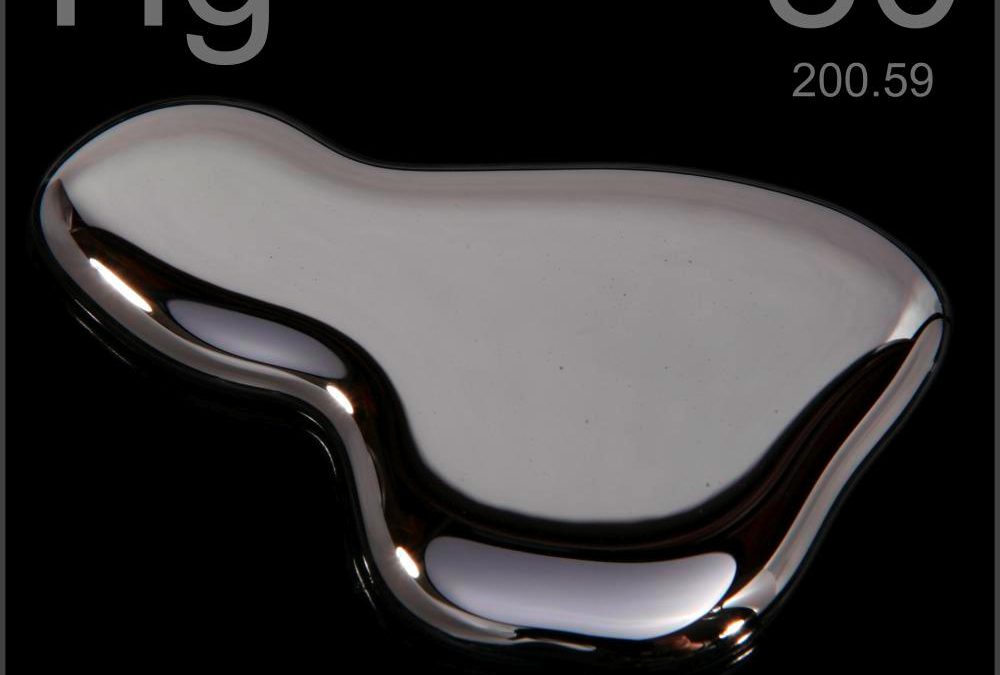
by Rick O'Connor | May 6, 2022
Imperiled (verb) – put at risk of being harmed, injured, or destroyed.
In 2021 the Florida Department of Environmental Protection classified 44 area waterways in the Pensacola Bay System as imperiled. Such designations are based on an environmental parameter making it unhealthy for one reason or another. When we think of an unhealthy body of water, many times we think of sewage. There are nine bodies of water in the Pensacola Bay System classified as imperiled due to the fecal bacteria concentrations within. There are another seven for bacteria levels high enough to close them for shellfish harvesting. This is a total of 16 bodies of water having bacteria issues (36% of the 44 designations).
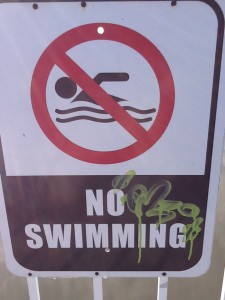
Closed due to bacteria.
Photo: Rick O’Connor
Low dissolved oxygen and fish kills is another parameter we think of. There are four waterways designated imperiled due to high nutrients (a cause of hypoxia and fish kills), and one for low dissolved oxygen readings itself. This is a total of five (11% of the 44 designations).
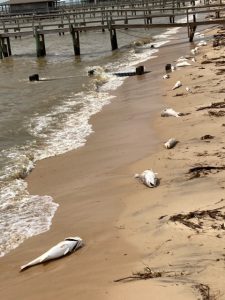
Dead redfish on the eastern shore of Mobile Bay.
Photo: Jimbo Meador
But you may be surprised to learn that 23 of the 44 imperiled water bodies (52%) are designated based on the mercury content of the fish sampled there.
Most people are aware of the mercury issue in fish. Many of those living in the Pensacola Bay area are aware of this issue locally, but they may not be aware that with the 2021 designations, it is the primary reason for many listed. To be fair, it is not that mercury issues are increasing, it may be more that there are 97 waterways in the Pensacola Bay System being considered for delisting in 2021 and those are listed for a variety of other issues. What it is stating is that with the 44 that remain imperiled, mercury is the primary cause.
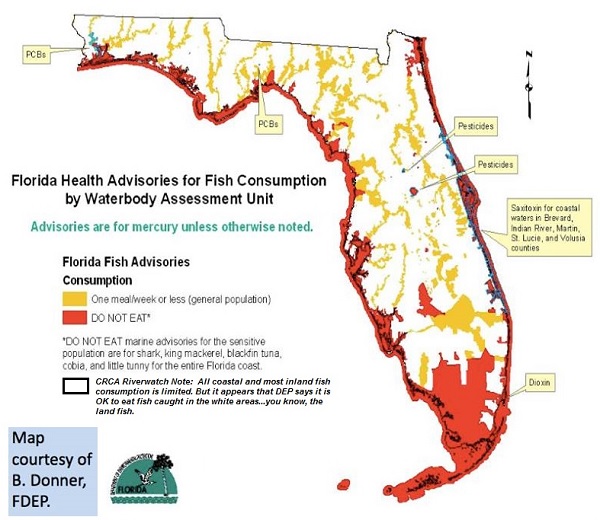
We have all heard of mercury in fish, but where is it coming from? What health problems does it cause? And is there anything that can be done to make these bodies of water healthier?
Mercury is a naturally occurring element on the periodic table. It is element #80, meaning it has 80 protons and electrons, one of the larger naturally occurring elements. It is a silver-colored liquid at room temperature, one of only two naturally occurring elements in the liquid phase at these temperatures – the other being bromine. It is sporadically found throughout the earth’s crust, usually combined with other elements. There are two forms of mercury – mercury (I) and mercury (II) – indicating the number of cations available for sharing or transferring in compound bonding. Mercury (II) is more common in nature.
The element has been of interest to humans for centuries. There are records of it buried beneath the Mayan pyramids, though we are not sure how it was used, and it was used in Chinese medicine centuries ago. The Spanish used it to help extract silver from mines during their colonial period around the world. It was also used in separating fir from skin in felt hat making in the 19th century. Hatters who used this method eventually had neurological problems and became known as “mad hatters”, an idea used in Lewis Carol’s Alice’s Adventures in Wonderland.
In more modern times it has been used in fillings for tooth cavities (including my own) and preserving specific vaccines. Being a good conductor of electricity and not of heat, it is used in numerous electrical components, fluorescent lighting, and batteries. Some cultures used it to help “whiten their skin” and a common use is in the processing and production of certain industrial chemicals. Today, due to the toxic properties of mercury, many of these uses are no longer.

Fluorescent lighting contains mercury.
Mercury is obtained for these uses by mining their ores. The most sought after ore is cinnabar, a red-colored rock found around the world. Mercury (II) sulflide (HgS) is a common compound found in cinnabar. When heated and oxidized it will produce sulfur dioxide and elemental mercury.
HgS + O2 à Hg + SO2
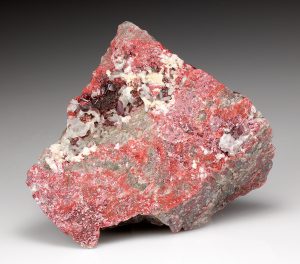
Cinnabar is the most common ore mined for mercury.
Photo: Classic Crystal
The problem with mercury is that it is toxic, and some forms of mercury are more toxic than others. The element is known to cause brain, kidney, and lung issues. It also can weaken the immune system. It is most known for the neurological problems it causes. Sensory impairment, lack of motor skill coordination, psychotic reactions, hallucinations, tremors and spasms have all been connected to exposure to mercury. There are concerns with the neurological development within the fetus if exposed to mercury and many of the health advisories target women of childbearing age who are pregnant or considering it. They have included the very young and the very old in their recommendations that these members of the population do not eat more than 6 ounces of fish (or shellfish) that have high mercury contamination.
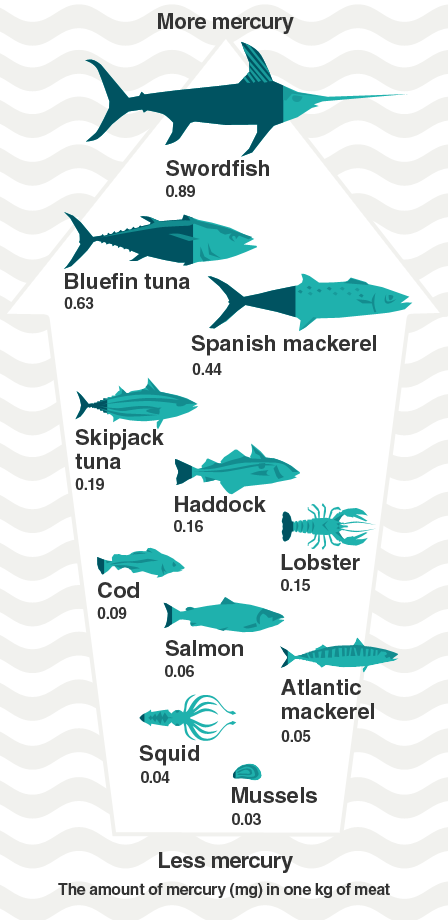
Mercury contamination in fish.
Image: BBC
The organic forms of mercury, dimethylmercury and methylmercury, are the more toxic forms. These are introduced to the environment both naturally and from human activity. Once in the aquatic environment they are absorbed by the phytoplankton (microscopic plants in aquatic environments). Methylmercury accumulates in lipids (fats) within the cell at relatively low concentrations (phytoplankton are not large). However, they are not passed by the creature. The slightly larger zooplankton (microscopic animals) feed on the phytoplankton and accumulate the mercury they have stored. Feeding on a lot of these, they accumulate even more mercury. The zooplankton are consumed by small fish, who eat a lot and accumulate even more mercury. Then the mid-sized fish consume them, and the larger fish consume those, and on and on. The top predators have accumulated enough methylmercury to be hazardous to human health IF they are consumed by people. This process of increasing the concentration of mercury through the food chain is known as biomagnification – “magnifying the problem”.
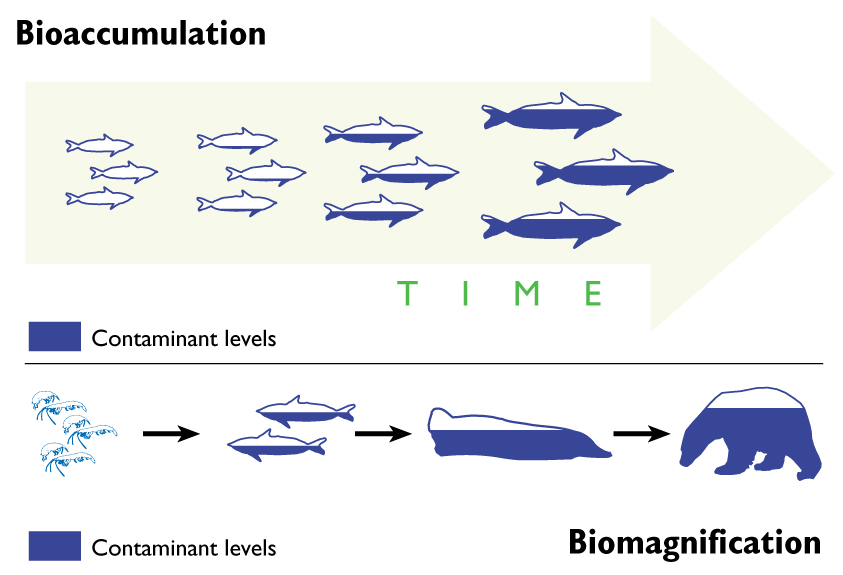
So, which fish are of concern?
Based on the Florida Department of Health for freshwater systems in Escambia County.
- Bluegill, Channel catfish, Largemouth bass, Long-eared sunfish, Red-eared sunfish, Spotted sunfish and Warmouth from the Escambia River system – you should not eat more than one/week.
- Do not eat chain pickerel or largemouth bass – and do not consume more than two red-eared sunfish from Crescent Lake.
- Lake Stone near Century FL – no more than two bluegill and sunfish per week and no more than one largemouth bass each week.
- From the Perdido River do not eat more than two bluegill or sunfish each week and do not eat largemouth bass from the Perdido River.
- The same species and regulations apply for the Yellow River system as well.
The following marine species are of concern….
Almaco jack, Atlantic spadefish, Atlantic croaker, Weakfish (trout), Black drum, Black grouper, Blackfin tuna, Bluefish, Cobia, Dolphin, Pompano, Gafftop catfish, Gag, Greater amberjack, Gulf flounder, Hardhead catfish, King mackerel, Ladyfish, Lane snapper, Bonito, Mutton snapper, Pigfish, Red grouper, Red snapper, Sand seatrout, Scamp, Shark, Sheepshead, Snowy grouper, Southern flounder, Southern kingfish, Spanish mackerel, Spot, Striped mullet, Vermillion snapper, Wahoo, White mullet, Yellow-edge grouper, and Yellowfin tuna.
In each case it is not recommended eating more than two servings a week. For a few, it is recommended that the most vulnerable people mentioned earlier not at ANY… Those would include Blackfin tuna, Cobia, King mackerel, Bonito, and Shark.
It is recommended that NO ONE eat king mackerel over 31 inches and any shark species over 43 inches in length.
I guess as you look at this list, you see fish species that you like. This list can lead folks to think… “I am just not going to eat seafood”. This would be a mistake. The Department of Health has found there are essential vitamins and nutrients provided be seafood that are missing if you do not eat them. They found additional problems in fetal development when seafood protein was left out of the mothers’ diet. So, the response would be… eat other seafood species you do not see on this list… or, if you see something you do like, no more than 1-2 6-ounce servings per week.
So, is there anything we can do about the mercury issue in our bay system?
Well, to have the biggest impact you will need to determine the biggest source. 33% of the mercury in our environment comes from natural sources, such as volcanic eruptions. We can do nothing about volcanic eruptions, or other natural sources, so we will need to look at anthropogenic (human) sources.
The larger sources would be anthropogenic, which account for 67% of the known mercury in the environment, focusing on these can make a large impact. Coming in at No.1 – producing electricity by burning coal. This accounts for 65% of the anthropogenic sources. Moving away from burning coal would make a huge difference. But that is easier said than done. Mining and burning coal are important for the economy of many communities. It is one of the cheaper methods of producing much needed electricity. But in addition to producing mercury compounds during the heating process, many other toxic compounds are produced and released as well – not to mention the amount of greenhouse gases produced during this process. Hence the name “dirty coal”. There are other methods of producing electricity and the solution would be to convert not only the power plants to these methods, but the coal dependent communities to this line of work. This one step would make a big difference.

Power plant on one of the panhandle estuaries.
Photo: Flickr
At a much smaller scale, mining for gold produces 11% of the mercury from the mine tailings, cement production (7%), and incinerating garbage (3%). Though not a large player in this game, reducing the amount of solid waste burned each year would help reduce the mercury issue.
The takeaway here is that the number of imperiled waterways in the Pensacola Bay System have been reduced over recent years and we will look at this in another article. But for those that remain, mercury is the prime reason. It is also important to understand that mercury is a naturally occurring element and can not be broken down, so we have what we have – but, we can stop adding to the problem. Third, eating some seafood each week is good for you. You will just need to select species that are not problems or watch how much you eat if you prefer some of the listed species.
For more information on the 2021 imperiled waterways list visit
https://floridadep.gov/dear/watershed-assessment-section/content/final-lists-impaired-waters-group-4-cycle-2-basins
For more on the seafood safety species lists visit
https://dchpexternalapps.doh.state.fl.us/fishadvisory/
Other sources for this article included:
Wikipedia – https://en.wikipedia.org/wiki/Mercury_(element)
Miller, G.T., Spoolman, S.E. 2011. Living in the Environment. Brooks and Cole Cengage Learning. Belmont CA. pp. 674.
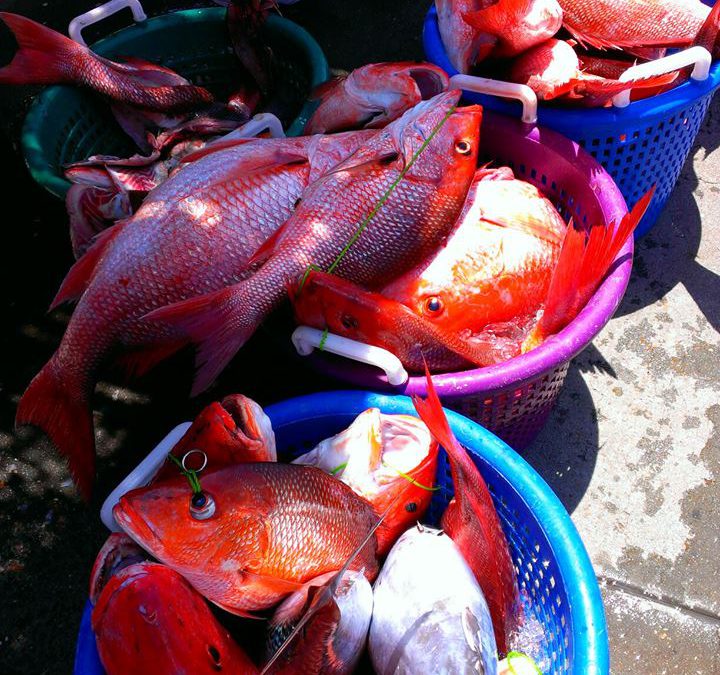
by Rick O'Connor | Jul 6, 2018
Shrimp, oysters, blue crab and fish have been harvested from the Pensacola Bay System (PBS) for decades, although there has been a decline in all in recent years. Annual landings (in pounds) have ranged from
- Fish 66,000 – 4,600,000 (most are scaienids)
- Brown shrimp 43,000 – 906,000
- Oysters 0 – 492,000
- Blue crab 400 – 137,000
There is a concern about the safety of seafood harvested from our estuary… sort of. Many local residents and visitors ask frequently about the safety of these products. However, when programs are held to provide this information they are not well attended, and when articles are posted – few view them. I think there is a concern for the safety of seafood products, particularly those from our estuaries – so I cannot explain the lack of interest in the presentations and articles.
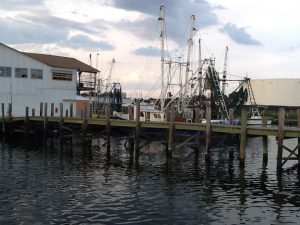
Commercial seafood in Pensacola has a long history.
Photo: Rick O’Connor
One contaminant that gets a lot of press is mercury. The toxic form of mercury is methylmercury. This form of mercury impairs brain development of fetuses – hearing, vision, and muscle function in adults. Studies suggests that the primary source of mercury in the waters of the PBS is the atmosphere. Advisories have been issued for Escambia, Blackwater, and Yellow Rivers. There have also been advisories for local largemouth and king mackerel. This is one of the metals whose concentrations within the PBS is higher than neighboring estuaries – especially in our bayous (see https://blogs.ifas.ufl.edu/escambiaco/2018/06/13/restoring-the-health-of-pensacola-bay-what-can-you-do-to-help-bioaccumulation-of-toxins/.) Florida Department of Environmental Protection (FDEP) has issued Total Maximum Daily Loads (TDMLs) for mercury in the PBS.
So How Much is Too Much?
For monitoring purposes, total mercury (THg) is easier and less expensive to than the toxic form methylmercury (MHg). Many believe the amount of THg is equivalent to the concentration of MHg, and so it is used as a proxy for MHg.
Both the U.S. EPA and the FDEP recommend concentrations of THg not be higher than 0.3 ppm, and 0.1 ppm for pregnant women (or women planning a pregnancy).
Fish
Since 2000, four studies have been conducted on six species of fish in the PBS. Concentrations of THg ranged from 0.02 – 0.88 ppm and averaged between 0.2 – 0.4 ppm.
Blue Crab
Two studies have been conducted since 2007 found mercury concentrations ranged from 0.07 – 1.1 ppm.
Oysters
30 years ago, studies were finding concentrations of THg in oysters around 0.02 ppm. Repeated studies between 1986 and 1996 found an increase to 0.3 ppm.
Overall
Studies suggest that shrimp and oysters have lower concentrations of THg than blue crab and fish.
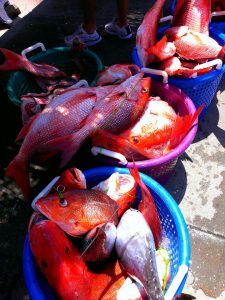
Seafood has a long history along Florida’s panhandle.
Photo: Betsy Walker
How often have samples exceeded the safe levels suggested by EPA, FDEP, and FDA?
| Group |
Recommended highest level |
% of times samples from PBS exceeded this limit |
| Subsistence Fishermen |
0.049 ppm |
50-90%
(89% for blue crab and oysters) |
| Pregnant females |
0.1 ppm |
50-90%
(88% for blue crab) |
| General public |
0.3 ppm |
5-20%
(12% for blue crabs)
(27% for fish) |
| Food and Drug Administration recommendation |
1.0 ppm |
0% |
The concern for mercury in local seafood has led to a reduction of consuming all seafood by pregnant women – period. Recent studies have shown this can have negative effects on the developing baby as well. The recommendation is to avoid fish that have been tested high in THg. Most of these are high on the food chain – such as king mackerel, shark, and swordfish. You can find the latest on seafood safety and advisories at https://myescambia.com/our-services/natural-resources-management/marine-resources/seafood-safety. Another piece of this story is the belief, by many, that selenium can lower the toxicity of MHg. Many believe that molar ratios of selenium and mercury greater than 1.0 can reduce the toxicity. However, there have been no studies on molar ratios of these elements in the PBS.
The bottom line on this issue is to be selective on the seafood products you consume.
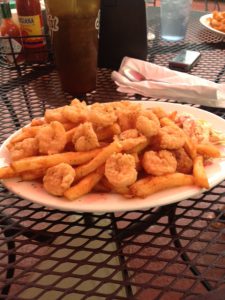
The most popular seafood species – shrimp.
Reference
Lewis, M.J., J.T. Kirschenfeld, T. Goodhart. 2016. Environmental Quality of the Pensacola Bay System: Retrospective Review for Future Resource Management and Rehabilitation. U.S. Environmental Protection Agency. Gulf Breeze FL. EPA/600/R-16/169.
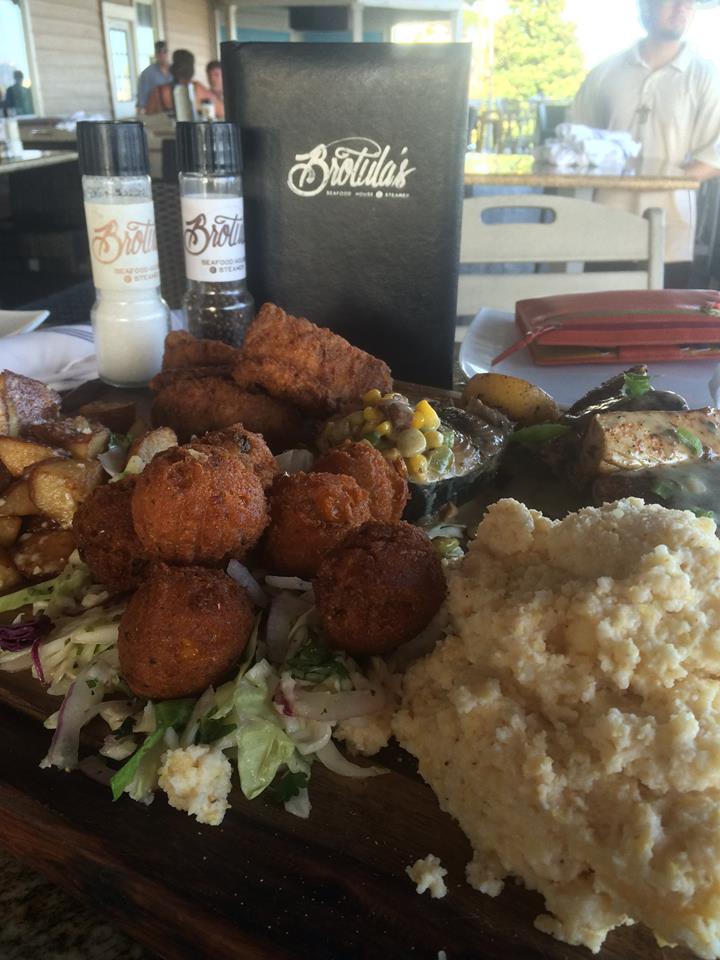
by Laura Tiu | Oct 7, 2016
I’ve spent the past 25 years studying and growing fish. When folks find out I’m a fish head, I often get a lot of questions about the safety and sustainability of many seafood products. It seems that the media and other groups have done a good job of scaring and confusing the American public to the point that some forgo consuming seafood altogether. That is such a shame because seafood is great for human health. Seafood is typically high protein, low in fat and calories and bursting with good for you stuff like omega-3s.
Seafood is either wild caught, aquacultured (farm-raised), or both. Both wild fisheries and aquaculture have their pros and cons. Overfishing, illegal fishing, bycatch, habitat degradation and lack of effective regulation have led to declines in wild fisheries. Aquaculture has been plagued with claims of pollution, disease and escapees. With all this negative press, what is the consumer to do?
You can choose your seafood based on its sustainability. Sustainable seafood has been caught or farmed in sustainable ways. And there are several groups today that make choosing these sustainable product easy. Once such group is the Monterrey Bay Aquarium. Their Seafood Watch program makes it easy for you to choose seafood that’s fished or farmed in ways that have less impact on the environment.
Using science-based criteria and input from fisheries and aquaculture experts, Seafood Watch has developed standards and guiding principles to develop consumer friendly guides. The guides are specific to each state and there is even one for sushi. These printable guides fit easily into your wallet so that you can use them anytime you purchase seafood. The guide shows with seafood items are “Best Choices” or “Good Alternatives,” and which ones you should “Avoid.” They also have an app for android and IPhone making it easier than ever to get the latest recommendations for seafood and sushi, learn more about the seafood you eat, and locate or share businesses that serve sustainable seafood.
As consumers, we have a lot of power in the seafood marketplace. With over 75% of the world’s fisheries either fully fished or overfished, we need to make smart choices about the seafood we buy and consume. By supporting fisheries and fish farms that are working hard to limit their impact on the environment we help protect the seafood we love. By using the seafood guide for your region, you’re making choices based on the best available information and supporting environmentally friendly fisheries and aquaculture operations.
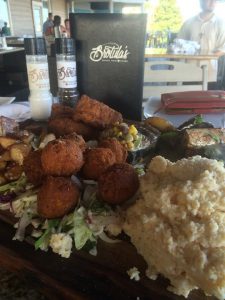
Brotula’s Restaurant in Destin, Florida will cook your fresh catch to perfection.
by Scott Jackson | Nov 14, 2012
Holiday dinners usually feature ham and turkey. You may start having left-over sandwich nightmares after eating turkey for the next six weeks! Many Florida families choose fresh seafood as a delicious and healthy addition to their traditional holiday meals.

Fish on a thick bed of ice with bellies down. Courtesy of Florida Sea Grant
This is a great time of year to purchase and enjoy seafood. There is quality fish, shrimp, and shellfish currently at your local grocery store or seafood market. Usually with the holidays, there’s more time to explore new recipes in the kitchen. Fresh ingredients are the key to any good recipe and helps ensure healthy eating. The National Oceanic and Atmospheric Administration (NOAA) FishWatch website (www.fishwatch.gov) provides consumers with information regarding seafood nutrition, safety, and sustainability.
FishWatch suggests the following when shopping for fresh fish:
- To be sure the safety of seafood is being properly preserved, only buy fish that is refrigerated or properly iced. Fish should be displayed on a thick bed of fresh ice that is not melting and preferably in a case or under some type of cover. Fish should be arranged with the bellies down so that the melting ice drains away from the fish, thus reducing the chances of spoilage.
- Fish should smell fresh and mild, not fishy, sour, or ammonia-like odors.
- A fish’s eyes should be clear and bulge a little (except for a few naturally cloudy-eyed fish types, such as walleye pike).
- Whole fish and fillets should be firm and spring back when pressed.
- Fish should have shiny flesh and bright red gills free of slime. Dull flesh could mean the fish is old. Note: Fish fillets that have been previously frozen may have lost some of their shine, but they are fine to eat.
- Fish fillets should display no darkening or drying around the edges. They should have no green or yellowish discoloration and should not appear dry or mushy in any areas.
Fresh Florida Oysters are almost as popular during the holidays as pecans and walnuts; they are just a little more difficult to crack! Oysters are a welcomed addition to any meal, as side dishes, appetizers, or snacks between larger meals. You’ll enjoy finding great ways to prepare this nutritious shellfish.
Consumption of raw seafood such as oysters is not recommended for those whose immune systems are compromised. For example, patients completing chemotherapy or folks with blood or digestive disorders are at a higher risk for contracting bacterial infections. Ask your doctor if you have a question whether you are at higher risk. Properly cooked oysters (plump, opaque, and curled edges) are healthy choices. Cooking kills bacteria associated with raw seafood. For more information on oyster consumption and recipes visit http://safeoysters.org
One recipe that complements the traditional bird is oyster dressing. With this recipe you can enjoy both turkey and seafood together. For more oyster and seafood recipes like this one, visit www.fl-seafood.com
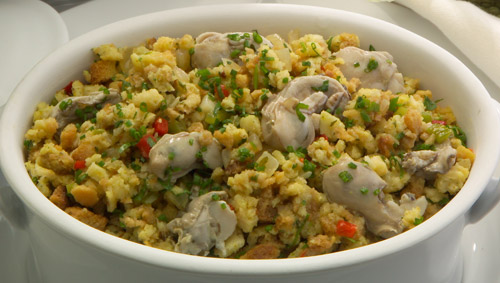
Complement a traditional holiday meal with seafood dish like oyster dressing. Courtesy of Florida Dept of Agriculture and Consumer Services (FDACS)
Ingredients:
12-ounces Florida oysters
½ c. Florida celery, chopped
½ c. Florida onion, chopped
¼ c. butter
4 c. day-old bread cubes
1 tbsp. fresh Florida parsley, chopped or 1 tsp. dried parsley
1 tsp. sage
½ tsp. salt
1/8 tsp. poultry seasoning
1/8 tsp. teaspoon pepper
Preparation:
Preheat oven to 325° F. Drain oysters; reserve liquid. Remove any remaining shell particles. Chop oysters. Cook celery and onion in butter until tender. Add oysters and oyster liquid to vegetables; cook for 10 minutes. Combine oysters, cooked vegetables, bread cubes and seasonings in a large bowl; mix thoroughly. If stuffing seems dry, moisten with additional oyster liquid or chicken broth. Bake dressing in a greased casserole dish for 30 minutes.

















